How to Plant Fig Tree: From Soil Prep to First Harvest
- March 26, 2024
- 0 comment
Learn how to plant Fig Trees, a delightful addition to any garden known for their lush foliage and sweet fruit. Belonging to the Mulberry family and scientifically named Ficus carica, these trees are native to the Mediterranean but can thrive in diverse climates with proper care. This guide will help you cultivate these delicious and ornamental trees in your own garden, regardless of where you are in the world.
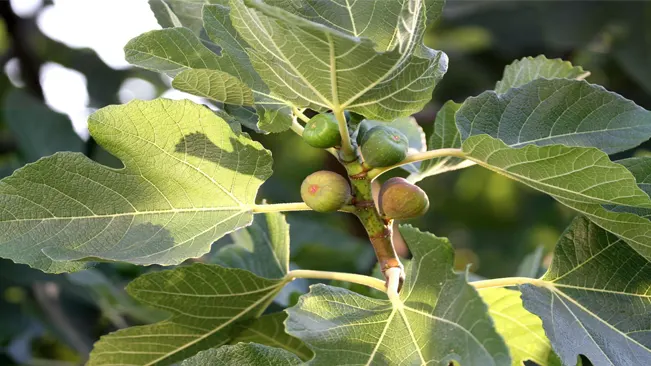
Benefits of Fig Tree
| Nutritional Value | High in dietary fiber, aiding in digestion. Rich in vitamins A, B1, B2, and minerals such as manganese, magnesium, calcium, copper, potassium, and iron. Contains antioxidants like flavonoids and polyphenols. |
| Health Benefits | Promotes digestive health, helps in treating constipation. Supports bone health due to high calcium content. Aids in regulating blood sugar levels. Potassium-rich, which helps in managing blood pressure. Contributes to heart health by reducing cholesterol levels. Anti-inflammatory properties may assist in reducing the risk of chronic diseases. |
| Culinary Uses | Versatile in cooking: can be used in desserts, salads, and savory dishes. Can be consumed fresh, dried, or as a jam. Enhances flavor profiles in both sweet and savory recipes. |
| Skin Health | Possesses moisturizing and antioxidant properties. Used in natural skincare for hydrating and rejuvenating the skin. |
| Weight Management | High fiber content helps in feeling full and can assist in weight management. |
| Traditional Remedies | Used in traditional medicine for various purposes, including respiratory, digestive, and reproductive health. |
| Environmental Impact | Fig trees contribute to biodiversity, supporting various species of birds and insects. Provides natural shade and enhances the aesthetic value of landscapes. |
List on How To Plant Fig Tree
- Choosing the Right Fig Tree
- Selecting the Planting Site
- Preparing the Soil
- Planting the Fig Tree
- Watering and Mulching
- Pruning and Training
- Fertilizing
- Protecting Your Fig Tree
- Harvesting
Choosing the Right Fig Tree
Before planting, decide which variety of fig is best suited for your climate. Common varieties include Brown Turkey, Celeste, and Mission, each with its unique flavor and growth habits. Consider consulting local nurseries or agricultural extensions to identify the variety that will thrive in your area.
Understanding Fig Varieties
Brown Turkey
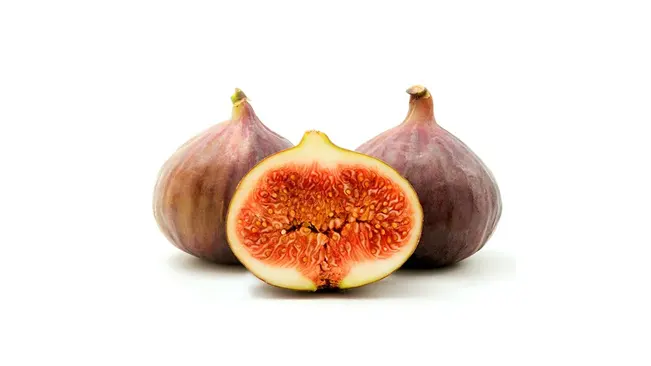
- This is one of the most popular fig varieties due to its adaptability and hardiness. It produces large fruits with a sweet, mild flavor and a purple-brown skin. It’s well-suited for cooler climates and is known for its ability to produce two crops a year in favorable conditions.
Celeste
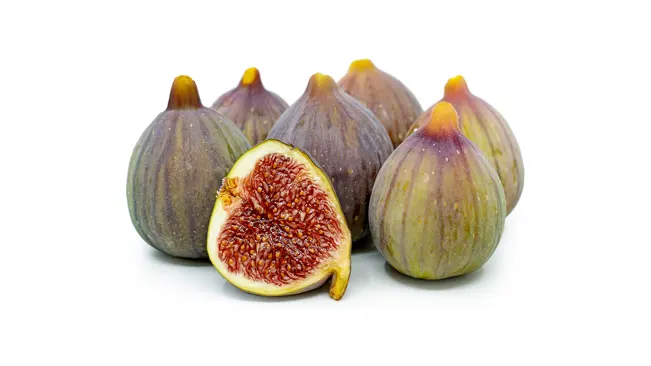
- Often called the “sugar fig,” Celeste has small, sweet fruits with a rich flavor and a purplish-brown skin. This variety is particularly cold hardy and is a good choice for northern climates. It is known for producing fruit that resists spoilage.
Mission

- Named after the California missions where it was first grown in the U.S., the Mission fig is known for its rich, sweet flavor. The fruits have a deep purple skin and a striking pink flesh. This variety is particularly well-suited to warmer climates and is known for its high productivity.
Considering Climate and Environment
- Temperature Tolerance: Some varieties, like Celeste and Brown Turkey, can tolerate cooler temperatures and are more suitable for northern regions. In contrast, varieties like Mission thrive in warmer, Mediterranean-like climates.
- Drought Resistance: Figs generally do well in dry conditions. However, some varieties might be more resilient to prolonged droughts than others.
- Humidity: Areas with high humidity can pose a challenge for fig cultivation due to increased risk of fungal diseases. Varieties with more open habits that allow air circulation can be better in these environments.
Other Considerations
- Space Availability: Consider the size of the mature tree. Some fig varieties can grow quite large, while others are more compact and suitable for smaller spaces or container growing.
- Fruit Use: Think about how you plan to use the figs (fresh eating, drying, cooking). Different varieties have different flavors and textures, which can influence their culinary uses.
- Local Advice: Consulting with local nurseries, agricultural extensions, or experienced fig growers in your area can provide invaluable insights into which varieties perform best in your local conditions.
Selecting the Planting Site
Figs require full sunlight and well-drained soil. Choose a sunny spot in your garden where the tree will receive at least 6 hours of sunlight daily. Avoid planting figs in low-lying areas where cold air or frost can settle. Figs do well in slightly acidic to neutral soil (pH 6.0-7.0).
- Sunlight Requirements: Fig trees thrive in full sunlight. This means they need a location where they can receive direct sunlight for at least 6 to 8 hours per day. Adequate sunlight is crucial for the tree’s growth, leaf development, and fruit production. The sunnier the spot, the sweeter the figs tend to be.
- Soil Conditions: The ideal soil for fig trees is well-drained. This is because fig trees are vulnerable to root rot if the soil retains too much moisture. If you have clay-heavy soil, which tends to hold water, amending the soil with organic matter like compost can help improve drainage. Figs also prefer a slightly acidic to neutral pH range, ideally between 6.0 and 7.0. You can test your soil’s pH with a kit available at most garden centers.
- Avoiding Cold Pockets: Fig trees can be sensitive to extreme cold, especially when they are young. It’s important to avoid planting them in low-lying areas of your garden where cold air or frost may settle. These areas can be significantly colder than other parts of your garden, which could damage or kill the tree.
- Wind Protection: While not as critical as sun and soil, providing some protection from strong winds can be beneficial, especially in more exposed areas. Wind can damage branches and leaves and may cause fruit to drop prematurely. A location near a fence or a wall can offer some shelter.
- Space Consideration: A mature fig tree can be quite large (up to 30 feet tall and wide, depending on the variety). Ensure there’s enough space for the tree to grow without being cramped by buildings, power lines, or other trees. Proper spacing not only allows for adequate growth but also ensures good air circulation, which is important for the health of the tree.
- Accessibility for Maintenance: Choose a site where you can easily access the tree for regular maintenance tasks like pruning, harvesting, and applying mulch or fertilizer.
Preparing the Soil
Prepare the planting site by loosening the soil to a depth of about 2 feet and a width of 3 feet. This helps the roots to penetrate the soil easily. If your soil is heavy or clayey, consider adding some organic matter like compost or aged manure to improve drainage.
- Loosening the Soil: The initial step involves loosening the soil to a depth of about 2 feet and a width of 3 feet. This depth is chosen to accommodate the spreading root system of the fig tree. Loosening the soil facilitates easier root penetration and expansion, which is essential for the tree’s access to nutrients and water.
- Assessing Soil Type: The type of soil in your planting area significantly affects the health of the tree. Fig trees prefer well-drained soils as they are susceptible to root rot in waterlogged conditions.
- Amending Heavy or Clayey Soil: If the native soil is heavy or clay-like, it’s crucial to amend it to improve drainage and aeration. This can be done by incorporating organic matter.
- Adding Organic Matter: Organic matter, such as compost, aged manure, or leaf mold, is beneficial for several reasons:
- Improving Drainage: It helps to break up dense, clayey soil, allowing water to drain more efficiently and preventing waterlogging.
- Enhancing Soil Structure: Organic matter contributes to the overall soil structure, making it more friable (crumbly) which is ideal for root growth.
- Nutrient Supply: It acts as a slow-releasing source of nutrients for the fig tree.
- Encouraging Beneficial Microorganisms: The addition of organic matter supports the growth of beneficial soil microorganisms that aid in nutrient breakdown and uptake.
- Checking Soil pH: Fig trees thrive in slightly acidic to neutral pH levels (around 6.0-7.0). If necessary, adjust the soil pH by adding lime (to increase pH) or sulfur (to decrease pH) according to soil test recommendations.
- Final Preparation: After amending the soil, it’s advisable to rake the area smooth and water it lightly. This settles the soil and prepares it for the tree planting.
Planting the Fig Tree
Plant your fig tree in the spring or early fall. If you have a potted tree, remove it from the container and gently loosen any circling roots. Dig a hole slightly larger than the root ball of the tree. Place the tree in the hole, making sure the root collar (where the roots meet the trunk) is level with the soil surface. Backfill the hole with soil and tamp down gently to remove air pockets.
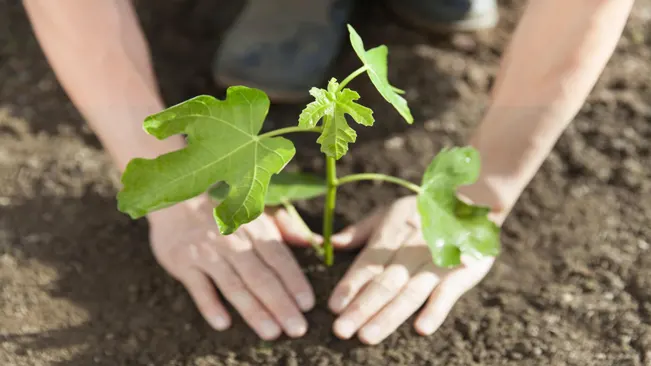
Optimal Planting Time
- Planting in the spring or early fall is ideal as these seasons provide moderate temperatures and adequate rainfall, which are beneficial for root establishment. In spring, plant after the last frost date to avoid cold damage. In fall, plant early enough so that the tree can establish roots before the ground freezes.
Preparing the Fig Tree
- If your fig tree is in a container, carefully remove it, ensuring you do not damage the roots. Loosening circling or bound roots is important; this encourages them to grow outward into the surrounding soil. However, be gentle to avoid excessive root damage.
Digging the Hole
- The hole should be slightly larger than the root ball. This extra space is crucial as it allows the roots to spread easily and facilitates better root-to-soil contact. A good rule of thumb is to make the hole twice as wide and just as deep as the root ball.
Positioning the Tree
- Place the tree in the center of the hole. The root collar (the point where the roots transition to the trunk) should be level with the surrounding soil surface. Planting the tree too deep can lead to root rot, while planting it too high can expose the roots to air and sun, which can dry them out.
Backfilling the Hole
- Fill the hole with the same soil you removed (unless it is very poor quality). Adding lots of organic matter or fertilizer can cause the roots to circle in the hole and not spread into the surrounding soil, which can limit the tree’s growth and stability.
Watering and Mulching
Water the tree immediately after planting. Keep the soil moist but not waterlogged, especially during the first growing season. Applying a layer of mulch around the base of the tree can help retain moisture and regulate soil temperature.
Watering
- Initial Watering: Right after planting the fig tree, it’s crucial to water it thoroughly. This helps settle the soil around the roots and eliminates air pockets.
- Frequency and Amount: During the first growing season, regular watering is essential as the tree establishes its root system. The frequency depends on your climate and soil type, but generally, the goal is to keep the soil consistently moist. Avoid extremes of dryness and waterlogging.
- Monitoring Soil Moisture: Check the soil moisture by feeling the soil a few inches below the surface. If it feels dry, it’s time to water.
- Watering Mature Trees: Once established, fig trees are quite drought-tolerant. However, they still benefit from occasional deep watering, especially in prolonged dry spells.
- Seasonal Adjustments: Reduce watering in the fall and winter when the tree is dormant.
Mulching
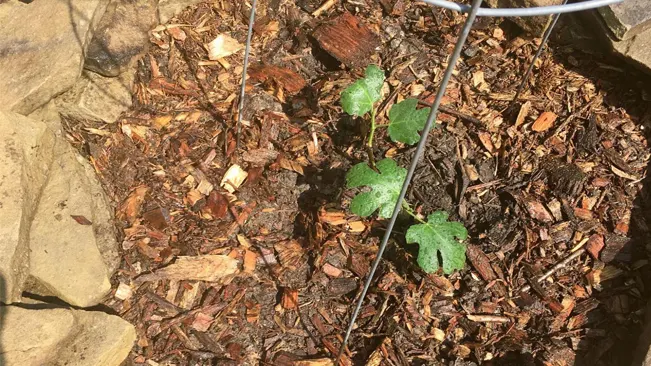
- Purpose of Mulching: Mulch helps retain soil moisture, suppresses weeds, and regulates soil temperature. It also adds organic matter to the soil as it breaks down.
- Types of Mulch: Organic mulches like wood chips, straw, or compost are ideal. They not only serve the purpose of mulching but also gradually enrich the soil.
- Application: Apply a 2-3 inch layer of mulch around the base of the tree, extending out to the drip line (the area directly beneath the outer circumference of the tree canopy). Avoid piling mulch against the trunk, as this can encourage rot and pest problems.
- Renewal of Mulch: Refresh the mulch layer as needed, usually once a year, to maintain its benefits.
Pruning and Training
Pruning is essential for fig trees, not just for shape, but also to improve air circulation and light penetration, which encourages healthy growth and fruit production. Prune your fig tree during its dormant season in late winter. Remove any dead or diseased branches, and thin out crowded branches.
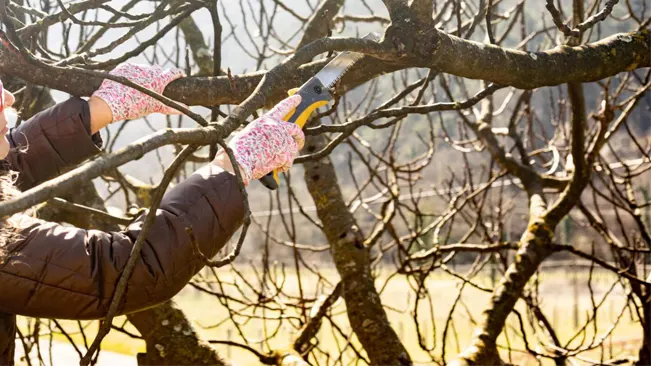
The Importance of Pruning
- Shape and Size Control: Regular pruning helps maintain a manageable size and shape for your fig tree, making it easier to harvest and care for.
- Improving Fruit Quality: By removing excess branches, you allow more energy to be directed towards fruit production, often resulting in larger and sweeter figs.
- Enhancing Sunlight and Air Flow: Pruning opens up the canopy, improving air circulation and sunlight penetration. This reduces the risk of fungal diseases and promotes healthier growth.
- Stimulating New Growth: Pruning encourages the growth of new, healthy branches which can lead to increased fruit production in subsequent seasons.
When to Prune
- Late Winter Pruning: The best time to prune a fig tree is during the late winter while the tree is dormant. This timing minimizes sap loss and reduces the risk of disease infection.
Pruning Techniques
- Removing Dead or Diseased Wood: Always start by cutting away any branches that are dead, diseased, or damaged. This keeps the tree healthy and prevents the spread of diseases.
- Thinning Out: If branches are crowded, thin them out to improve light and air penetration. Be careful not to over-prune; usually, removing about a third of the total canopy is sufficient.
- Heading Back: Cut back overly long or unruly branches to maintain the desired shape. Make cuts just above a bud that faces the direction you want the new growth to take.
- Lateral Pruning: Encourage lateral growth (growth that is horizontal rather than vertical) for easier harvesting and to promote a more bushy growth habit.
Fertilizing
Fertilizing fig trees is an important aspect of their care, but it requires a balanced approach. Unlike many fruit trees, figs are relatively low feeders, meaning they don’t need a large amount of supplemental nutrients if planted in decent soil. The key is to provide enough nutrition to support healthy growth and fruit production without encouraging excessive vegetative growth.
- Type of Fertilizer: A balanced fertilizer, typically one with an even N-P-K ratio like 10-10-10 or 8-8-8, is suitable for fig trees. Organic options, such as compost or well-rotted manure, can also be effective and improve soil health over time.
- Timing: The best time to fertilize a fig tree is in the spring as the tree breaks dormancy and begins new growth. This timing allows the tree to use the nutrients effectively for both leaf development and fruit production.
- Application Method: Apply the fertilizer around the base of the tree, extending out to the drip line (the area directly beneath the outer circumference of the tree branches). Avoid placing fertilizer too close to the trunk to prevent root burn.
- Quantity: Follow the instructions on the fertilizer packaging for quantities, as over-fertilization can lead to excessive leaf growth. In fertile soils, fig trees may require even less fertilizer than recommended.
- Signs of Over-Fertilization: Over-fertilized fig trees often exhibit lush, green leaf growth with little to no fruit. The tree might also become more susceptible to pests and diseases due to the tender nature of new growth induced by excess nitrogen.
- Additional Considerations: In poor soils, an additional application in early summer may be beneficial, but this should be done cautiously. Also, for container-grown figs, a regular but light fertilization schedule is necessary due to the limited nutrients available in the potting soil.
Protecting Your Fig Tree
In colder climates, fig trees might need some winter protection. Wrapping the tree with burlap or using a cold frame can help. Also, be on the lookout for pests like fig beetles and diseases such as rust.
Winter Protection
- Wrapping: In regions where temperatures drop significantly, wrapping your fig tree can provide essential protection. Use burlap or horticultural fleece to wrap the tree. Start from the base and work your way up, covering the main trunk and the primary branches. This wrapping helps to insulate the tree from harsh temperatures and frost.
- Mulching: Apply a thick layer of mulch around the base of the tree. This layer acts as an insulator for the roots, protecting them from freezing. Use organic materials like straw, leaves, or bark chips for mulching.
- Cold Frames: In areas with severe winters, consider constructing a cold frame around the tree. This structure, essentially a temporary greenhouse, can provide substantial protection against freezing temperatures and winds.
- Bringing Indoors: If your fig tree is in a container, the simplest protection method is to bring it indoors to a cool, frost-free place like a garage or basement during the coldest months.
Pest and Disease Management
- Fig Beetles: These beetles can be problematic, particularly in summer. To control them, keep the area around the tree clean and free of fallen fruit, which can attract these pests. In severe cases, insecticidal soaps or neem oil can be used.
- Rust: Fig rust, a common fungal disease, appears as orange-brown spots on the leaves. To manage rust, ensure good air circulation around your tree and remove any affected leaves promptly. Fungicides can be used if the infection is severe.
- Regular Inspections: Regularly inspect your tree for signs of pests or diseases. Early detection is key to effective control. Look for unusual leaf discoloration, spots, or signs of insect damage.
- Pruning: Proper pruning not only helps in maintaining the structure and productivity of the tree but also improves air circulation, reducing the risk of fungal infections like rust.
Harvesting
Fig trees usually start to bear fruit within two to four years of planting. Harvest figs when they are soft to the touch and have a rich color. Unlike some fruits, figs do not continue to ripen once picked.
Timing and Indicators for Harvest
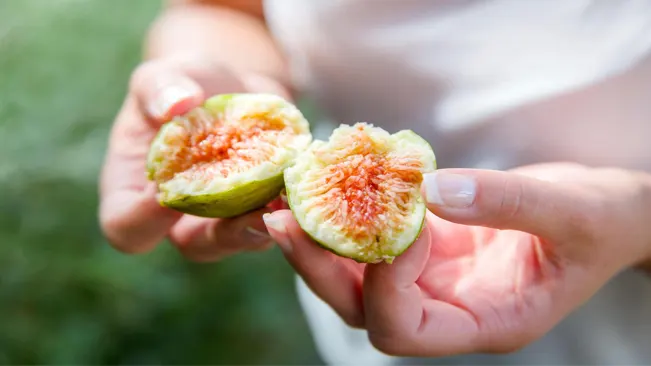
- Maturity Signs: Figs are ready for harvest when they become soft to the touch and droop slightly on the tree. The skin color will deepen, and some varieties may develop a slight crack in the skin. The exact timing can vary depending on the climate and the fig variety.
- Seasonality: The timing of the harvest varies but typically occurs from late summer to early fall. Some fig varieties can produce two crops a year – an early crop known as the “breba” crop in late spring and the main crop in late summer.
Harvesting Technique
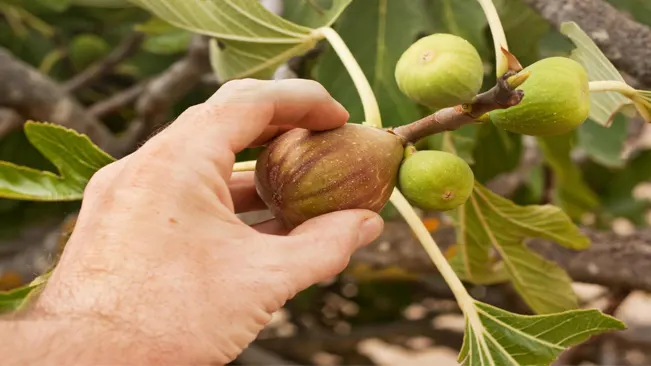
- Gentle Picking: Figs should be harvested gently to avoid bruising. Gently twist the fruit off the tree or use pruning shears to snip the stem.
- Regular Harvesting: Once figs start ripening, they may need to be harvested daily as they can quickly go from underripe to overripe.
Post-Harvest Handling

- No Ripening After Harvest: Figs do not continue to ripen after being picked, so it’s crucial to harvest them at the right stage of ripeness.
- Immediate Consumption or Processing: Due to their delicate nature and high sugar content, figs can ferment or spoil quickly. They should be eaten, refrigerated, or processed soon after harvesting.
- Storage: Fresh figs can be stored in the refrigerator for a few days. For longer storage, they can be dried, frozen, or made into jams and preserves.
Challenges in Harvesting
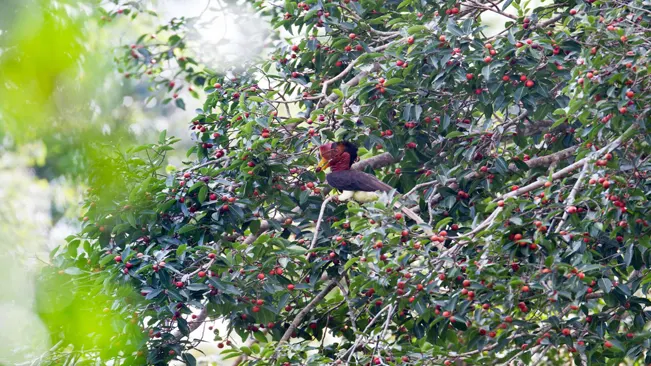
- Birds and Pests: Birds are fond of figs and can be a challenge during the ripening period. Netting or other deterrents may be necessary to protect the fruit.
- Climate Sensitivity: In climates with high humidity or rain, figs may split or sour before fully ripening. This requires careful monitoring and timely harvesting.
Health and Culinary Uses

- Nutritious Snack: Harvested figs are not only delicious but also rich in nutrients, offering a healthy snack or ingredient for various dishes.
- Versatility in Cooking: Fresh figs are excellent in salads, desserts, and cheese platters, while dried figs can be used in baking and as a snack.
Conclusion
Planting a fig tree successfully requires choosing a sunny location with well-drained soil, planting during the dormant season, and providing regular care through watering, pruning, and fertilization. These trees are adaptable and can thrive in various climates with the right attention, offering both aesthetic beauty and delicious fruits. With patience and proper maintenance, a fig tree can become a resilient and fruitful addition to any garden, enriching the landscape for years to come.
FAQs (Frequently Asked Questions)
- What is the best time of year to plant a fig tree?
- The ideal time to plant a fig tree is in the late fall or early spring during the dormant season.
- The ideal time to plant a fig tree is in the late fall or early spring during the dormant season.
- How much sun does a fig tree need?
- Fig trees require full sun, meaning at least 6 to 8 hours of direct sunlight daily.
- Fig trees require full sun, meaning at least 6 to 8 hours of direct sunlight daily.
- What type of soil is best for fig trees?
- Well-drained soil with a slightly acidic to neutral pH (around 6.0 to 7.0) is optimal for fig trees.
- Well-drained soil with a slightly acidic to neutral pH (around 6.0 to 7.0) is optimal for fig trees.
- How much space does a fig tree need?
- Allow about 15 to 20 feet of space in all directions for your fig tree to grow, though this can vary with different varieties.
- Allow about 15 to 20 feet of space in all directions for your fig tree to grow, though this can vary with different varieties.
- Do fig trees need a lot of water?
- Regular watering is important, especially during the tree’s first few years and in dry spells. However, avoid over-watering as fig trees are susceptible to root rot.
- Regular watering is important, especially during the tree’s first few years and in dry spells. However, avoid over-watering as fig trees are susceptible to root rot.
- How do I prepare the soil for planting a fig tree?
- Loosen the soil to a depth of about 2 feet and mix in organic matter such as compost or aged manure to improve fertility and drainage.
- Loosen the soil to a depth of about 2 feet and mix in organic matter such as compost or aged manure to improve fertility and drainage.
- Do fig trees need to be pruned?
- Yes, annual pruning in late winter is important for maintaining a good shape, removing dead or diseased wood, and promoting healthy growth and fruit production.
- Yes, annual pruning in late winter is important for maintaining a good shape, removing dead or diseased wood, and promoting healthy growth and fruit production.
- Can I plant a fig tree in a container?
- Yes, fig trees can be grown in large containers, but they will need more frequent watering and annual root pruning or repotting.
- Yes, fig trees can be grown in large containers, but they will need more frequent watering and annual root pruning or repotting.
- How long does it take for a fig tree to bear fruit?
- Generally, fig trees start bearing fruit within two to four years after planting.
- Generally, fig trees start bearing fruit within two to four years after planting.
- Do fig trees need fertilization?
- Light fertilization is beneficial, typically in the spring. Over-fertilization can lead to excessive leaf growth at the expense of fruit production.
For more expert gardening advice, explore our guides, discover top recommendations in our best section, and delve into in-depth product reviews in our review section.

Kristine Moore
Forestry AuthorI'm Kristine Moore, a seasoned garden landscaping professional with over 30 years of experience. My extensive career has been dedicated to transforming outdoor spaces into stunning, sustainable landscapes. With a deep understanding of horticulture, design principles, and environmental stewardship, I have become a respected figure in the field, known for creating harmonious, visually appealing, and eco-friendly gardens. My commitment to excellence and continuous learning in landscaping trends and techniques has solidified my reputation as an expert in garden design and implementation.













Leave your comment